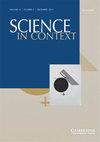Teresa Balough and Kay Dreyfus, eds. Distant Dreams: The Correspondence of Percy Grainger and Burnett Cross 1946–60 (review)
IF 0.5
4区 哲学
Q2 Arts and Humanities
引用次数: 0
Abstract
Percy Grainger (1882–1961) is frequently remembered as a virtuoso pianist, a collector of folk songs, and an idiosyncratic composer. Yet in addition to his other activities, he also designed and built numerous sound-producing machines. These experimental machines enabled Grainger to begin realising the experimental music he envisioned, that is, sounds freed from traditional rhythms and pitches. Grainger initially tried to create the new sounds he imagined with known instruments such as the theremin, but eventually began modifying instruments to create his own sound machines, such as the microtonal ‘butterfly’ piano. Grainger’s main collaborator, Burnett Cross (1914–1996), a high school science teacher with a background in both physics and music, helped to make those dreams a reality. Cross contributed technical expertise as the two worked together to bring Grainger’s ideas to life. Cross began working with Grainger in 1944 and became gradually more involved throughout the 1950s. By the late 1950s, Cross took the lead, especially with the electronic machine models. […]特蕾莎·巴洛和凯·德雷福斯主编。遥远的梦:珀西·格兰杰与伯内特·克罗斯1946-60年的通信(回顾)
珀西·格兰杰(1882-1961)经常被认为是一位钢琴大师、民歌收藏家和一位与众不同的作曲家。然而,除了他的其他活动,他还设计和制造了许多发声机器。这些实验机器使格兰杰开始实现他所设想的实验音乐,即从传统节奏和音高中解放出来的声音。Grainger最初试图用已知的乐器(如特雷门琴)创造出他想象中的新声音,但最终开始修改乐器来创造自己的声音机器,比如微调性的“蝴蝶”钢琴。Grainger的主要合作者Burnett Cross(1914-1996)是一位拥有物理和音乐背景的高中科学教师,他帮助实现了这些梦想。克罗斯贡献了技术专长,两人一起把格兰杰的想法变成了现实。克罗斯于1944年开始与格兰杰合作,并在整个20世纪50年代逐渐参与其中。到20世纪50年代末,克罗斯开始领先,尤其是在电子机器模型方面。[…]
本文章由计算机程序翻译,如有差异,请以英文原文为准。
求助全文
约1分钟内获得全文
求助全文
来源期刊

Science in Context
综合性期刊-科学史与科学哲学
CiteScore
0.80
自引率
0.00%
发文量
1
审稿时长
>12 weeks
期刊介绍:
Science in Context is an international journal edited at The Cohn Institute for the History and Philosophy of Science and Ideas, Tel Aviv University, with the support of the Van Leer Jerusalem Institute. It is devoted to the study of the sciences from the points of view of comparative epistemology and historical sociology of scientific knowledge. The journal is committed to an interdisciplinary approach to the study of science and its cultural development - it does not segregate considerations drawn from history, philosophy and sociology. Controversies within scientific knowledge and debates about methodology are presented in their contexts.
 求助内容:
求助内容: 应助结果提醒方式:
应助结果提醒方式:


